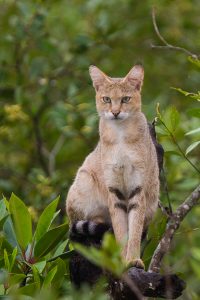JUNGLE CAT
 Scientific Name : Felis chaus
Scientific Name : Felis chaus- IUCN Status: Least concern
- Jungle cat is also called reed cat or swamp cat
- It has uniformly sandy, reddish brown or grey fur without spots; melanistic and albino individuals are also known.
- It is solitary in nature; except during the mating season and mother kitten families.
- It is a medium sized long legged cat and the largest of extant Felis species.
- The jungle cat is typical diurnal and hunts throughout the day.
- Its activity tends to decrease during the hot noon hours.
- Primarily a carnivore, the jungle cat prefers small mammals such as gerbils, hares and rodents.
- It hunts birds, fish, frogs, insects and small snakes.
- It hunts by stalking its prey, followed by a sprint or a leap; the sharp ears help in pinpointing the location of prey.
- Bot sexes become sexually mature by the time they are one year old.
- Major threats to the jungle cat include habitat loss such as the destruction of wetlands, dam construction, environmental pollution, industrialisation and urbanisation.
- Since the early 1990’s jungle cats are rarely encountered and have suffered drastic declines due to hunting and habitat destruction.
- The jungle cat is found in the Middle East, the Caucasus, the Indian subcontinent, central and Southeast Asia, Sri Lanka and in southern China. A habitat generalist, the jungle cat inhabits places with adequate water and dense vegetation, such as swamps, wetlands, littoral and riparian areas, grasslands and shrub.
